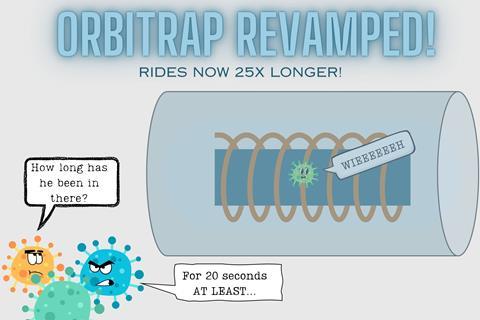
By playing with the hardware and software of a mass spectrometer, ions can be captured and analysed for much longer. This leads to very high sensitivity and resolution, write Utrecht researchers in Nature Methods.
In mass spectrometry (MS), molecules in the form of ions are ‘weighed’ with an electric field. Based on how fast or slow they pass through the field, you can deduce their mass. Nowadays, this can also be done with large biomolecules such as glycosylated antibodies or even whole viruses. You could use an orbitrap, which traps an ion in a box where it rotates around an electrode.
However, with the current length of time - 1 to 2 seconds - the sensitivity or resolution is quite low. Albert Heck’s biomolecular mass spectrometry group at Utrecht University therefore teamed up with Thermo Fischer Scientific and Spectroswiss to find an improvement. Using a new approach, they achieved a more than tenfold increase in effective measuring time (25 s), a fivefold improvement in signal-to-noise ratio and a 25-fold improvement in mass resolution.
Bypassing electronics
Normally, such a long measurement time for such large molecules is not possible because it generates a huge amount of data that the MS instrument cannot handle.
So how did the researchers do it? First, they collected the data using an external data acquisition system from Spectroswiss to bypass the electronics of the Thermo Fisher MS instrument itself. They also cleverly selected their ion signals by not recording anything below an m/z of, say, 2000, which gives far fewer data points.
Article continues below the image

The researchers then rewrote the Orbitrap’s software so that an ion stays in the MS longer. The MS’s own electronics then record the first second of the measurement for stabilisation purposes, while the external data acquisition system records for a longer period.
Theoretically, it is possible to record for several hours in this way, the authors write. In practice, however, you need to have a stable oscillation pattern, and that depends on the voltage of the central electrode. In the supplementary information, for example, they show a 60-second measurement. This works, but after about 26 seconds the quality of the signal drops. The researchers therefore estimate that the oscillations are stable for at least 25 seconds. In addition, the computer boards burned trough after 60 seconds, Heck said, and that was quite an expensive experiment: the computer boards cost about €15,000.
Gene therapy
In the discussion of the article - and in the UU press release - the researchers mention gene therapy as a field that could benefit greatly from this research. This is because the increased precision makes it possible to measure small differences even in large biomolecules. This is particularly useful if, for example, you want to use a virus to insert a new gene into the human genome for gene therapy. You can then measure the difference between a filled and an empty virus, allowing you to select for filled particles and use them more efficiently.
Deslignière, E. et al. (2024) Nat. Methods, DOI: 10.1038/s41592-024-02207-8












Nog geen opmerkingen